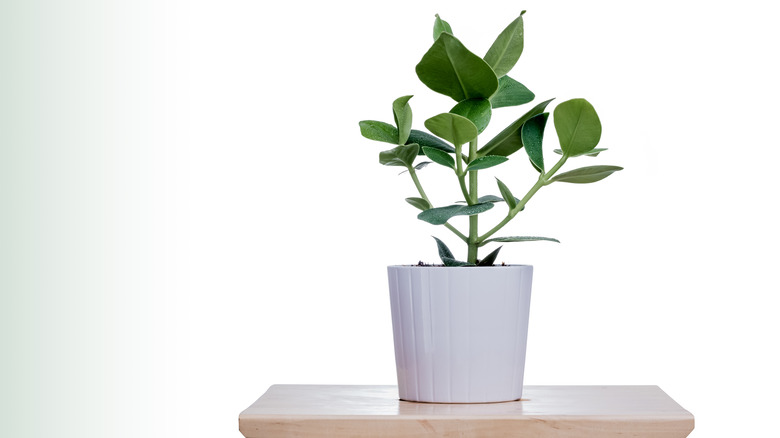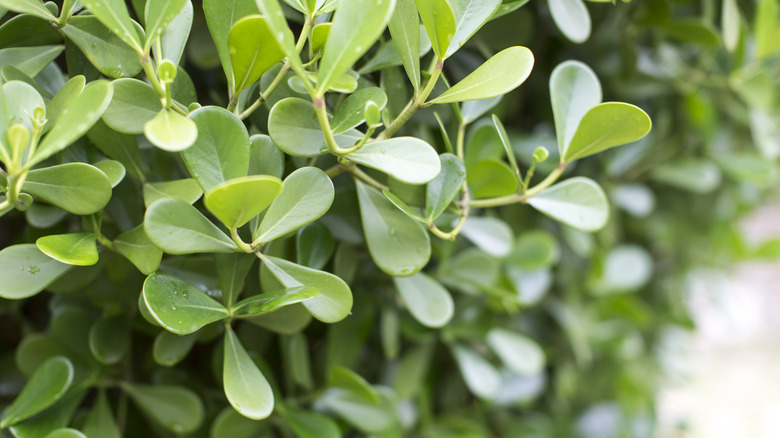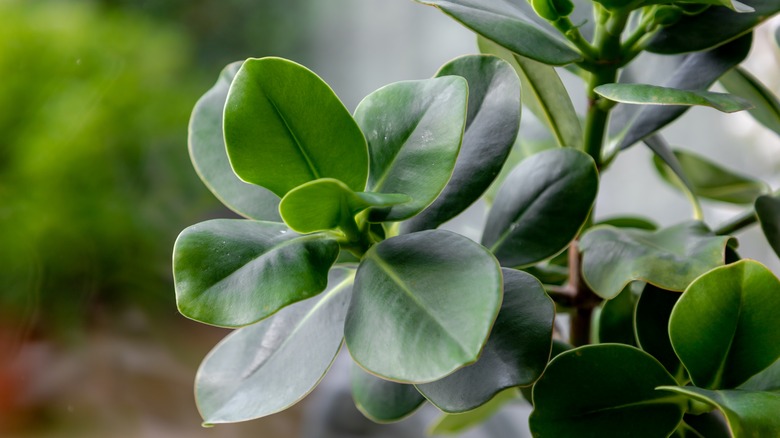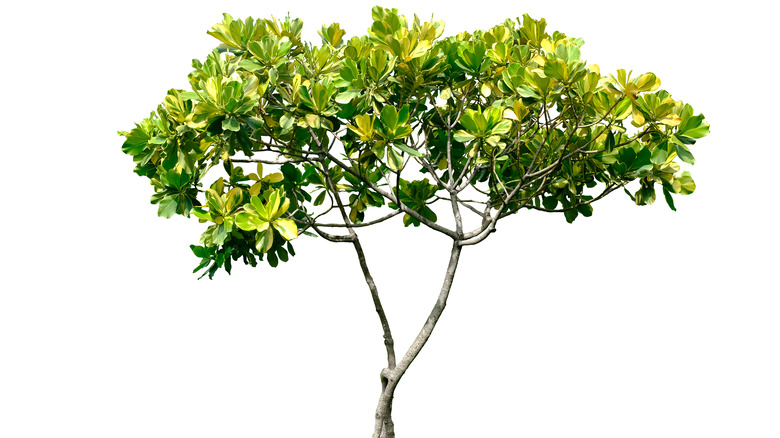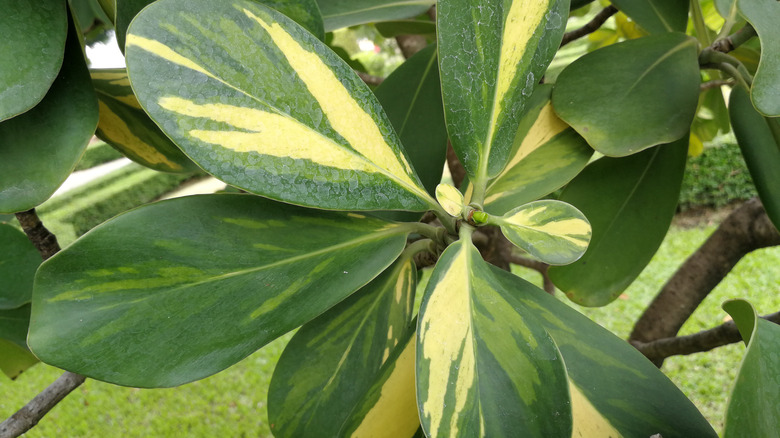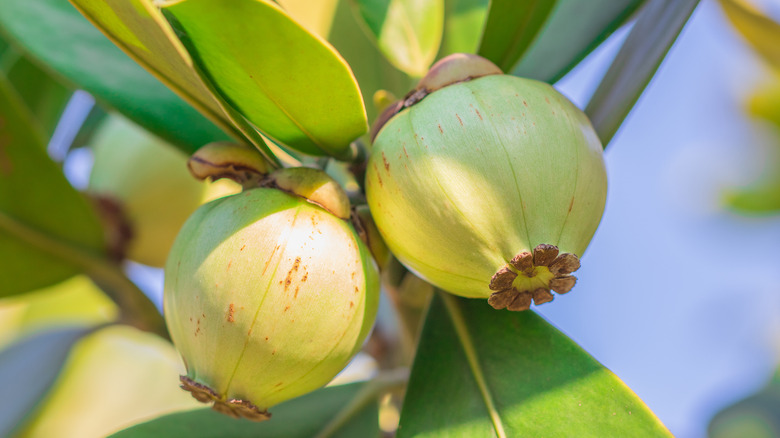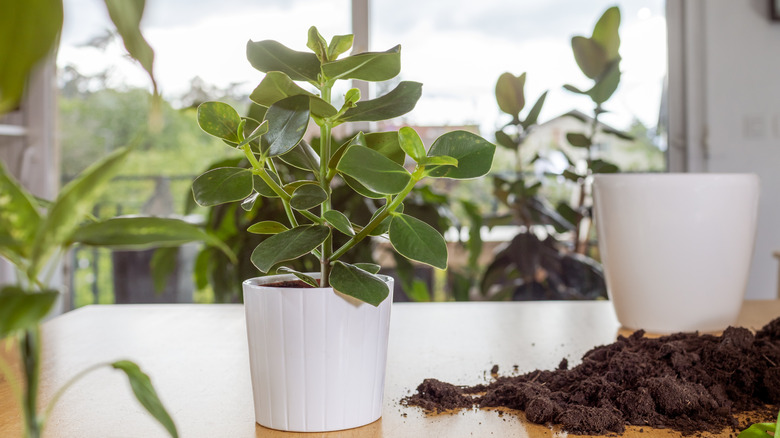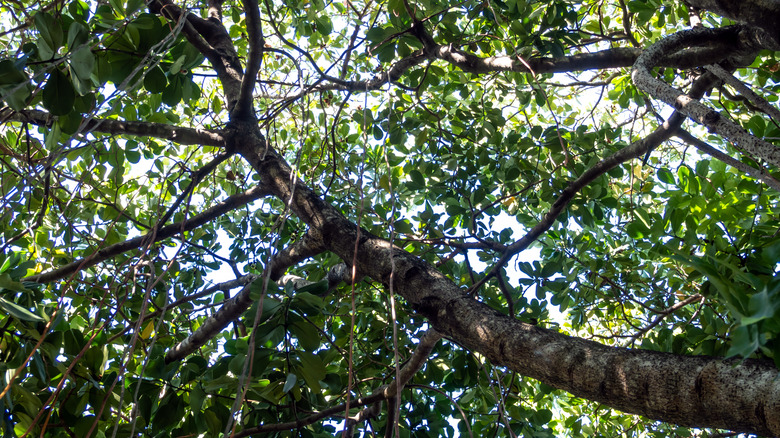How To Grow And Care For A Clusia Rosea Autograph Tree
Clusia rosea (Clusia for botanist Charles de l'Écluse and rosea for the pinkish color of its flowers) is classified by the Florida Native Plant Society as a long-lived perennial. With broadleaf evergreen leaves and fragrant pink and white flowers that open only at nighttime, these hardy plants are commonly packed together to form a thick hedgerow. Yet they are also popular as singular houseplants commonly called autograph trees, getting this nickname from their leather-textured leaves, which can be carved into with a fingernail or stick. The autographed etchings will remain on the leaves for the plant's life or until the leaf falls off.
A second, less often used nickname for Clusia rosea is Pitch Apple. This refers to the only poisonous part of this plant: its fruit. As it ripens, it discharges a black, sticky sap (similar to the resin of pitch pine) that, years ago, was used as caulking material for boats. Autograph trees need a climate zone of 10 or higher to grow outdoors. Within the United States, they are endemic only to a small region in the southernmost part of Florida, where they thrive amongst palm trees and tropical birds. Otherwise, they can grow well in containers so long as they are brought indoors anytime the temperature even thinks about cooling off. Specifically, that translates to keeping your clusia rosea above 50ºF at all times.
How to use an autograph tree in the garden
Clusia rosea seeds are often strewn far and wide by birds. New plants grow quickly and are known to naturalize themselves in new areas. This means they spread into non-native environments where they are able to reproduce and grow without human intervention. For the most part, this is seen as a positive aspect since the autograph tree's look and general hardiness are sought-after qualities.
Due to their expansive nature and thick waxy leaves, Landscape Plants For South Florida recommends using Clusia rosea in warm climates to create densely packed hedges or privacy screens. Left to grow to their full height, they can stretch up to 35 feet, creating an almost impenetrable wall. The plants have a high salt tolerance, making them a common sight near the ocean, but in non-tropical environments, autograph trees will need to stay in containers and be moved before the arrival of autumn. This way, they can be pruned back to a manageable shape and size and make a nice addition to a garden. More often than not, however, they are sold as indoor house plants.
How to grow an autograph tree
Outdoor Clusia rosea in the tropics require little attention. Nature will happily do the work for you if you plant your trees in appropriately sunny areas. However, indoor potted autograph trees need a little more in the tender loving care department. Some key factors indoors are temperature (60-84ºF) and humidity (misting may prove helpful). Your potted autograph tree loves the sun just as much as the planted one, so keep it in the brightest spot in your house, preferably near a south-facing window with a few hours of full sun exposure.
Once you inevitably fall in love with your tree, consider taking cuttings to grow new ones. Since they spread so easily on their own, it makes sense that they would also be easy to propagate. Per The Spruce, all you really need to do is cut off a stem and plant it in its own grow pot full of pre-moistened potting soil. Once it roots down and stays firm with a gentle tug, it will be ready to transplant to a larger pot.
How to care for an autograph tree
According to the University of Florida's IFAS Extension, Clusia rosea does well in clay, sand, or loamy soil. It can handle either alkaline or acidic pH levels, and its main necessity in all soil cases is sufficient drainage. This will hold true for both indoor and outdoor plants. Potted ornamentals will acclimate to some time in an area of indirect light, but avoid keeping it in full shade. Outdoors, these sun lovers are fairly drought tolerant, but that doesn't mean you don't need to water them. Yes, they'll survive if you forget, but they'll be happiest and healthiest if you remember. Leafy Place suggests watering new plants anytime the soil has started to dry out. You can hold back to only adding water during extended periods without rain with mature plants.
Is it hot? Go ahead and give your plant an extra drink. So long as you've followed the important rule of ensuring proper drainage, your trees will appreciate the additional hydration. Without proper drainage, you may start to see yellowing leaves and excessive drop-off, two signs of over-watering and possible root rot. Check to make sure drainage holes are not clogged and that your plant is not stuck in a pool of standing water. Another factor to keep in mind with outdoor plants is trimming the aerial roots to restrict them from causing new plants to sprout up outside of the planned landscape area.
Autograph tree varieties
Autograph trees are grown for their gorgeous foliage, brilliant flowers, and fruits and are native to Mexico, Florida, and parts of Central America, the Caribbean, and northern South America. According to The Spruce, there are roughly 150 Clusia species, but only Clusia rosea, or the signature tree, is widely cultivated. Here are a few other varieties that might interest you.
- Clusia rosea 'Nana' is a dwarf variety of the original Clusia rosea, Everglades notes. This semi-succulent with small leaves plant is very easy to care for. It rarely flowers, requires little to no pruning and will top out at about 2 feet tall and 2 to 3 feet around.
- Clusia guttifera (small leaf Clusia) is a small shrub with a single trunk that flowers less often and is mostly used for hedges. Per South Florida Plant Guide, Clusia guttifera are sometimes mislabeled in plant stores as Pitch Apple trees. It's important to check the tag for the scientific name, so you're certain you're purchasing the right variety. Left to shrub out, this tree's leaves will fill the area flush to the ground.
- Clusia rosea 'Variegata' with variegated leaves is also called Clusia major. With striking pink and white splashes against the standard green leaves, this variety is a popular choice for anyone looking to add an extra pop of color to their landscape design, mentions National Parks' Flora & Fauna Web page.
Is the autograph tree toxic?
The Pitch Apple fruit is the one part of a Clusia rosea that is toxic to both humans and pets, causing gastrointestinal irritation and vomiting when ingested. This irritation comes from terpenes, which are chemical compounds produced naturally in the plants that create aromas, smells, and colors related to diverse vegetation types, Healthline writes. Surprisingly, when the fruit eventually splits open, the seeds that come out are not poisonous. Those seeds can be eaten by wildlife, including birds, who often scatter them around, thus perpetuating the growth of new plants.
If this fruit is toxic, why does the autograph tree remain such a popular plant? The answer may lie in the simple fact that they are visibly pleasing and incredibly easy to take care of. It also may be that while consuming the fruit will cause upset, its risk level is not considered lethal. Consider killing two birds with one stone by using a plant stand to elevate your autograph tree to window height. This will allow for better sun exposure while getting the tree up off the floor and away from the curious mouths and noses of pets and children. Then, when young fruit appears after flowering, remove it immediately. Always employ caution in the case of a beloved pet munching on a house plant. As soon as symptoms appear, contact your local veterinarian or the 24-hour ASPCA Animal Poison Control Center.
How to repot your autograph tree
Leaf discoloration, roots sneaking out the drainage holes at the bottoms of pots, and soil that is not retaining moisture are all clear signs that your Clusia rosea is ready for new digs. There's nothing tricky here, so all you need to do is gather the standard materials. A well-draining potting soil mix, a slightly larger pot, gardening gloves, and a watering recipient will do it. You may also want to take this opportunity to fertilize your plant. For this, Smart Garden Guide recommends a general-purpose option, like a 10-10-10 fertilizer mixed to half strength. Cutting the strength of your mixture ensures you'll benefit your small house plant without overdoing it.
Get your new pot ready with fresh soil and pre-measured fertilizer. Loosen your plant by grasping it at the base and flipping it over. Tap gently on the bottom of the pot to release. Once it's securely positioned in the new pot, backfill any remaining holes with more soil and water generously. Repotting always gives a plant a small shock, so it's a good idea to place your plant right back in the same comfortable sunny spot it was living in before.
The autograph tree as an invasive plant
The Clusia rosea autograph tree is enjoyed as a delightful ornamental shrub by many people worldwide. On the flip side, it is also listed in the Global Compendium of Weeds due to its highly invasive nature. Written by Roderick P. Randall and originally published in 2002, the compendium contains a list of 21,000 plants considered to be weeds. Clusia rosea is particularly harmful in Sri Lanka and Hawaii, where it was introduced in the 1930s. However, according to the Hawaii Ecosystems at Risk (HEAR) project, its invasion is so far gone that, at this point, it would likely be impossible to eliminate the plant.
The problem with Clusia rosea in these non-native areas is that their seeds are spread far and wide by birds. The hardiness of the seeds allows them to germinate and grow anywhere they are dropped, often at the crotch or juncture of two branches, on a host tree. There, they grow as epiphytes, relying only on oxygen and moisture from the air to flourish. Aerial roots grow down and, over time, they engulf and then completely smother out the other tree. Just like strangler figs, Clusia rosea can also be found perched on rocks with aerial roots growing downwards for many yards before reaching the ground. Unfortunately, these trees are popular and continue to be planted regularly, even though they are choking out other species native to the islands.
